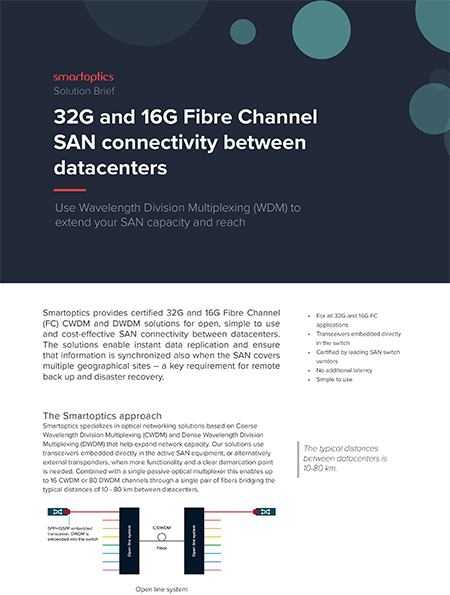WHAT IS A SAN (storage area network) AND HOW DOES IT PROTECT MISSION-CRITICAL WORKLOADS?
Enterprises increasingly see downtime as a substantial risk, given that just an hour of downtime can cost $700,000. The most surefire way to secure uptime for mission-critical workloads is to have a solid disaster recovery plan with synchronous data mirroring as a key component. But how do you do that? A storage area network (SAN) is a good starting point. But from there, you’ll still need to make key decisions like what protocol to choose, when to use a SAN and how to deploy it.
What is a storage area network (SAN)?
A storage area network (SAN) is a high-speed network that consolidates blocks of data across storage devices and connects them to servers. SANs access storage devices through servers so that they appear as directly attached from the server’s operating system. Frequently used in enterprise data centers with mission-critical workloads and sensitive data, a SAN is commonly referred to as the network behind the servers.
A SAN is typically used for applications that require high performance, low latency, and high availability—such as databases, virtualization platforms, enterprise resource planning (ERP) systems, and backup and disaster recovery solutions. By centralizing storage resources, a SAN enables efficient data sharing across multiple servers while simplifying administration and scaling.
At a technical level, a SAN uses a dedicated storage network—separate from the standard local area network (LAN) - to transport block-level data between servers and storage devices. This is often implemented using Fibre Channel, iSCSI, or NVMe over Fabrics. Servers access volumes on the SAN as if they were local disks, thanks to mapping and zoning technologies that securely isolate and present storage to specific hosts. Advanced features like multipathing, snapshots, and replication further increase reliability and data protection. This architecture allows organizations to pool storage resources for greater flexibility, allocate capacity dynamically, and support mission-critical workloads with predictable, high-speed performance.
The difference between a SAN and DAS
In direct-attached storage (DAS), individual disks are attached to a computer through a server. On the other hand, a SAN interconnects all disks and operates separately from the common local area network (LAN). A SAN enables greater data availability and performance with rapid duplication and transfer across almost any number of storage devices. This is one of the reasons SANs makes disaster recovery much easier.
The difference between a SAN and NAS
SAN and NAS are both designed for managing enterprise data storage resources centrally and linking these resources with servers. However, SAN uses block-based protocols like Fibre Channel and iSCSI while NAS uses file-based protocols like SMB and NFS. In block-level storage, multiple storage devices each contain multiple blocks of storage. These blocks are treated like separate hard drives and controlled collectively from a server. In file-level storage, individual storage devices, also called file servers, share files and folders directly with users.
NAS uses a shared network and SAN uses a dedicated network for delivering shared storage. This enables SANs to optimize and accelerate storage traffic performance while improving data protection and availability. This is because there’s no single point of failure in a SAN with robust deduplication, encryption, replication and self-healing capabilities that can be centrally monitored and managed.
NAS is suited for ease of use and cost of ownership while SAN is known for its higher performance and lower latency, making it a more suitable choice for mission-critical workloads.
What protocols can a Storage Area Network use?
There are four main types of SAN protocols to consider when deploying your SAN network:
- Fibre Channel Protocol (FCP)
- Internet Small Computer System Interface (iSCSI)
- Fibre Channel over Ethernet (FCoE)
- Non-Volatile Memory Express over Fibre Channel (FC-NVMe).
Traditionally, FCP has been the most common SAN protocol followed by iSCSI. However, FCoE and FC-NVMe have been experiencing rapid growth in SANs and are forecast to continue being used more widely in the coming years. One of the greatest differentiators between these SAN protocols is whether they run on Fibre Channel or Ethernet.
The difference between Fibre Channel and Ethernet-based SAN protocols
Fibre Channel-based protocols like FCP use a Small Computer System Interface (SCSI) with an underlying Fibre Channel connection. Ethernet-based protocols like iSCSI runs SCSI commands over traditional Ethernet. As a result, Fibre Channel SAN networks don’t have to compete with other traffic for capacity and generally offer better performance and lower latency. However, Ethernet-based protocols like iSCSI SAN can sometimes be simpler to integrate into existing network infrastructure and thus more cost–effective and flexible. FCP also provides better security and compliance controls while iSCSI can support faster speeds and longer distances over Ethernet.
If your disaster recovery plan and backup application require synchronous mirroring, then you’ll need to opt for FCP. FCP is the only SAN protocol that enables synchronous mirroring, making it popular for workloads subject to strict regulatory requirements such as in the banking and finance sector.
How do you deploy a SAN?
The majority of all FC SANs are within metro regions with <100km distances, especially SANs that require synchronous mirroring. Therefore, high-speed transponders are not needed in most cases and embedded solutions for deploying a Fibre Channel SAN can be more effective. This means plugging the DWDM transceivers directly into the FC switch. As a result, the signal is kept in the physical layer, which significantly reduces latency. An embedded SAN can also cut costs, including both upfront investment and ongoing operating costs. Read more about Smartoptics embedded solutions.
Smartoptics offers solutions for all types of 32G/16G Fiber Channel SAN connectivity, whether using embedded transceivers or transponder based DWDM networking. Download our solution brief to learn more about using WDM to extend your SAN capacity and reach.
Want to know more about our approved solutions for Fibre Channel? Read about our approved Brocade collection and our Cisco approved fiber channel solutions.

Learn about pluggable DWDM FC solutions
32G and 16G Fibre Channel SAN connectivity between datacenters

Get the Brocade Gen 7 guide
Download the guide to get everything you need to know to upgrade and set up your DCI for optimum performance with Gen 7
Related articles

What is Fibre Channel used for?

What is DWDM and when should you use it?
